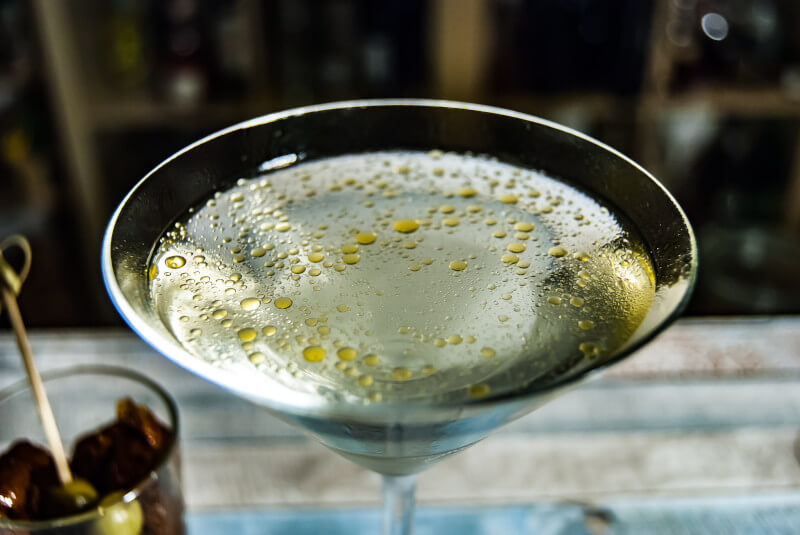When you walk into a bar and ask for a Martini, there’s a plethora of ways that drink could be presented. But fret not, this guide aims to equip you with all the knowledge you need to order your Martini confidently. This isn’t just about getting a drink; it’s about understanding the art behind it.
The Martini’s Evolution
Originating in the late 1800s, the Martini has seen a fascinating evolution. Initially, it was a sweeter concoction made with sweet Italian vermouth. By 1905, the definition of a “Dry Martini” emerged, which had equal parts of gin and vermouth, eventually seeing the substitution of sweet vermouth with dry.
David Wondrich, the esteemed author of The Oxford Companion to Spirits and Cocktails, noted that by the 1950s, the Martini’s composition shifted from at least 5 parts gin to 1 part vermouth. The rise of vodka’s popularity in the ’60s meant that this spirit also found its place in the Martini glass.
Today, with the cocktail renaissance, many bars have reverted to early 20th-century Martini recipes. These often incorporate a 2:1 mix of spirit to vermouth, sometimes with the addition of orange bitters.
Deciphering Vermouth
Vermouth, especially dry vermouth, complements the Martini with its subtle aromatics. The ratio of alcohol to vermouth can range widely from 2:1 to as extreme as 7:1, depending on the bar’s preference. Establishments like New York City’s Bemelmans Bar opt for a 7:1 ratio, while others like Musso & Frank Grill in Los Angeles serve up a gin or vodka drink minus the vermouth.
If you’re uncertain, consider the 50/50 Martini, which balances booze and dry vermouth. Another approachable option is the Dirty Martini, which incorporates olive brine, toning down the spirit’s intensity.
Shaken or Stirred?
The consensus among seasoned bartenders is to stir Martinis and Manhattans, as they contain only spirits and liqueurs. Stirring ensures minimal dilution, maintaining the drink’s rich texture. However, don’t shy away from a shaken Martini. As Rachel Napoleon from Bernie articulates, shaking can super-chill a vodka Martini, highlighting its crispness. The choice is, ultimately, about personal preference and how you want the drink to feel.
Finishing Touches: Olive or Twist?
How you garnish your Martini adds the final character. While a lemon twist introduces brightness, olives add a hint of saltiness. As Pollak puts it, the twist awakens the cocktail, and the olive offers a salty treat. Casuga and Pollak both often opt for a combination of both.
Decoding Martini Lingo

Because there are so many ways to customize a Martini, a whole language of slang terms has grown up to answer the age-old question, “How would you like it?” Here are some of the most popular Martini words, but keep in mind that from bar to bar, the exact ingredients will vary.
- 50/50: In the early 20th century, this is how most Martinis were made. It is made with half spirit and half dry vermouth.
- Bone-Dry: If you ask for a Martini without vermouth, you usually get a dry drink.
- Dirty: A Dirty Martini is a spin on the classic Martini. Olive brine is added to the mix to make it a Dirty Martini. In some places, like Bemelmans and Musso & Frank’s, olive oil is used instead of some or all of the dry vermouth. Spoon & Stable and Temple Bar are two bars that use brine instead of vermouth in their drinks. Most of the time, vodka is the main liquor in a Dirty Martini that has been shaken, but this is not always the case.
- Dry: Less dry vermouth is used in a Dry Martini than in a standard Martini. The amount of spirit to vermouth can be anywhere from 5:1 to 8:1, but most of the time, your barman will cut back on the vermouth and add more spirit.
- Extra-dirty (or filthy): Simply put, this Martini has more olive brine than a Dirty Martini and often more dry vermouth than a standard Martini calls for. Most brine amounts are between one and two ounces. Temple Bar also has a house mix that combines spirit and brine in a 50/50 ratio.
- Extra-dry: Even less dry vermouth is used in an Extra-dry Martini than in a Dry Martini. Most bars only use vermouth to rinse the glass or coat the inside with a very small amount of dry vermouth before throwing away the rest.
- Gibson: In the Gibson, instead of an olive or lemon twist, a cocktail onion is used to finish off a Martini. A standard Martini recipe will be used, but if you want it changed, make sure to include your favorite Martini ratios and preparation method.
- On the rocks: You are welcome to ask for ice with your Martini. If you want your drink to last longer, this might be a good way to do it. It keeps the drink at the right temperature, dilutes it, and lets the flavors develop. Martinis are often served automatically, and most bartenders won’t stop to ask if you want one, so you have to say it.
- Perfect: Most of the time, the amount of spirit to vermouth in a Perfect Martini is 2:1. But the vermouth is split evenly between sweet and dry vermouth. The drink that comes out of this is more fragrant and sweet than a traditional Martini. Pomajzl says that the sweet vermouth gives the drink depth and creaminess.
- Reverse: In a Reverse Martini, the usual 1:1 mix of vermouth to gin or vodka is turned around. This is a great option if you like vermouths or want to show off the flavors of some artisanal vermouths you’re trying. It’s also a great idea to ask for a non-alcoholic drink for lunch, like a Martini.
- Straight up: This word shouldn’t be used when talking about Martinis because it could be misunderstood. The barman may hear that as “no vermouth,” but it could also be a different way of saying “up.” Just telling the barman “no vermouth” will make the Martini without the ingredient.
- Up: “Up” means that the drink is in a cocktail glass without ice after it has been squeezed. You don’t have to ask for a martini very often when you place an order.
- Wet: The dry vermouth in a Wet Martini can be changed by up to half an ounce, based on the bartender’s taste. Some bars may have the same rules for a Wet Martini as for a regular Martini, while others may have different rules. Spoon & Stable’s famous Wet Martini is made with Old Tom gin and white vermouth, which give the drink a richer flavor and a hint of sweetness.
- With a twist: If you ask for a ‘Martini with a twist’, the barman knows you don’t want an olive but rather a twist of lemon peel.
